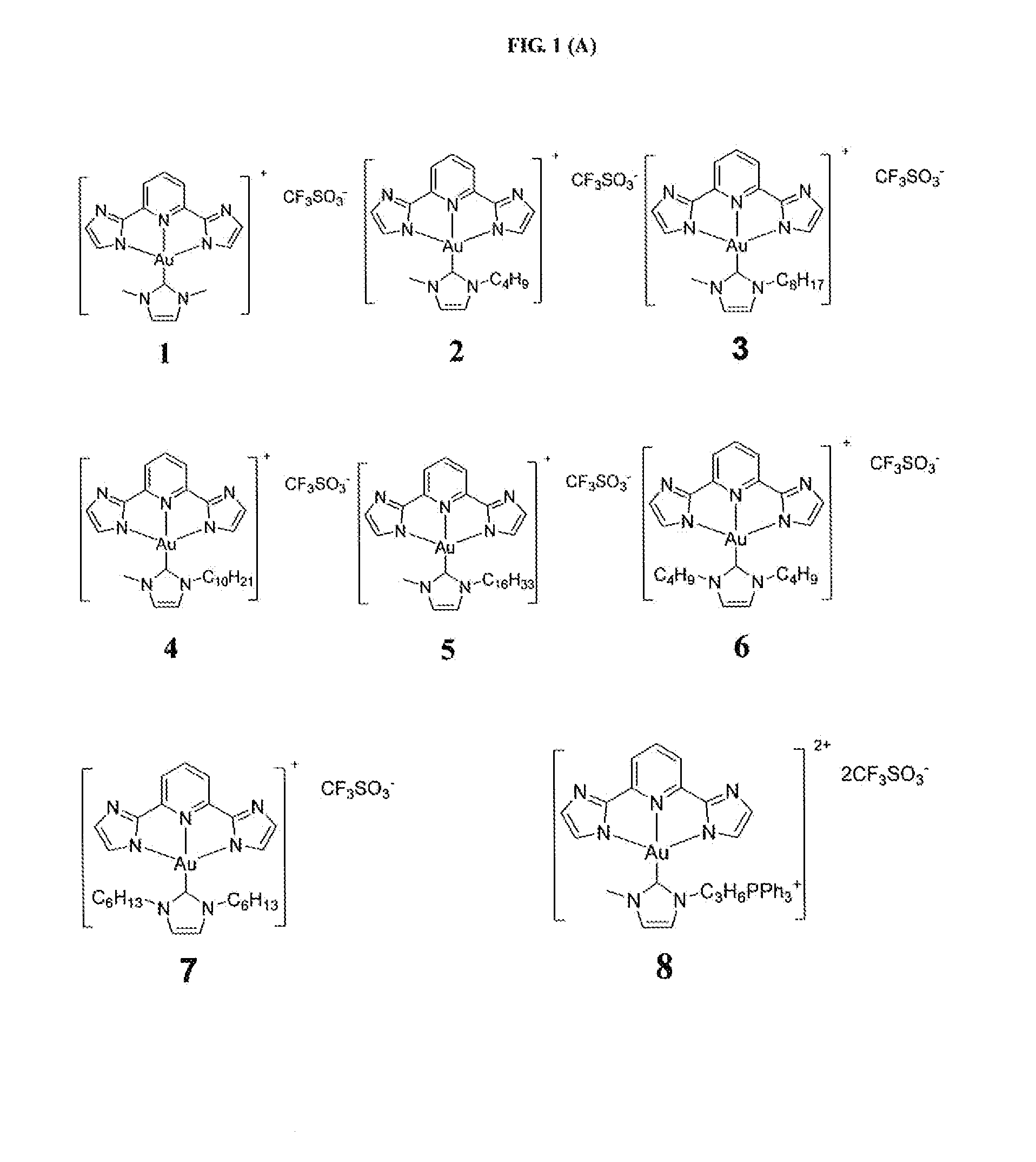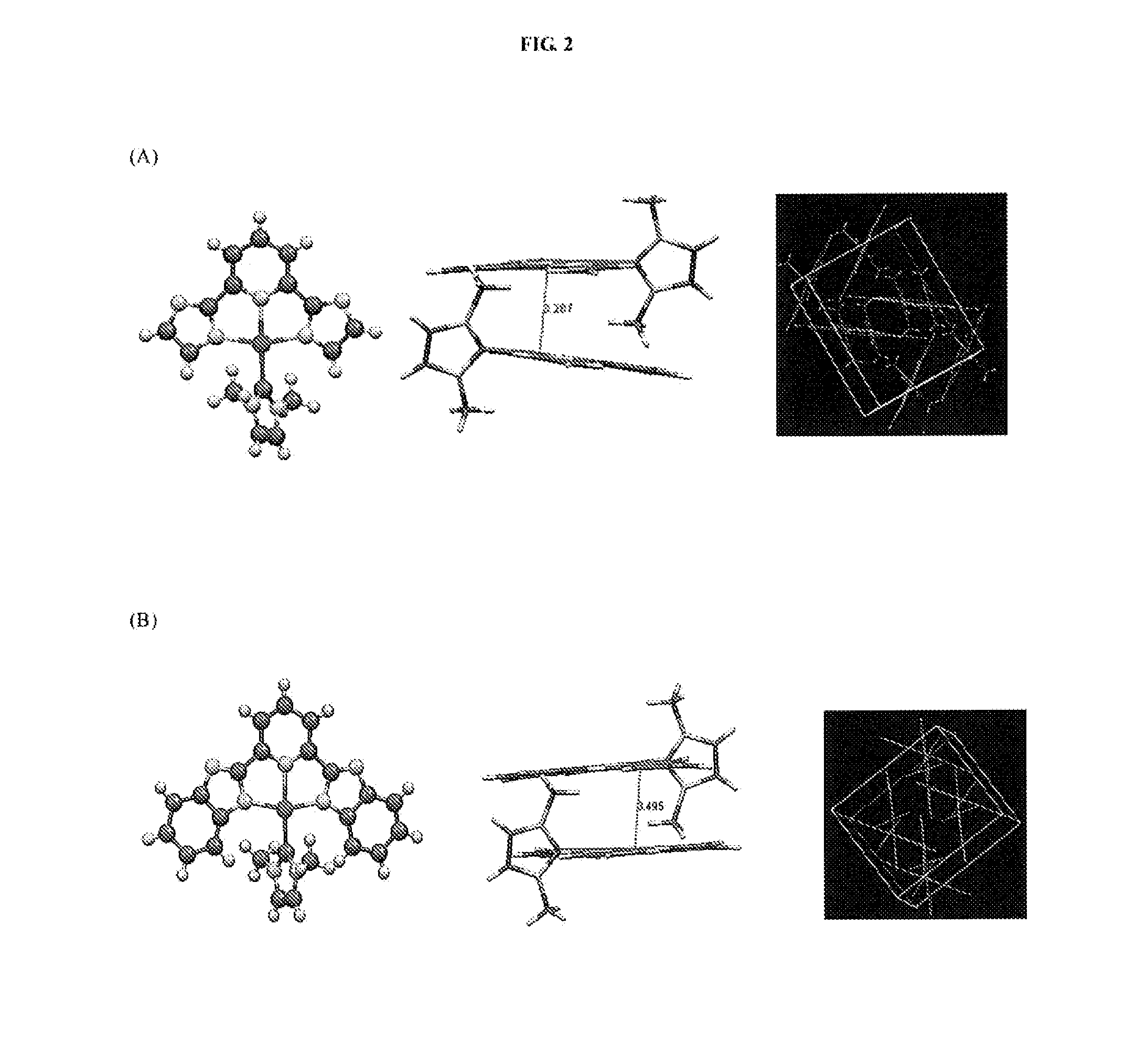Novel gold(III) complexes containing n-heterocyclic carbene ligand, synthesis, and their applications in cancer treatment and thiol detection
a technology of n-heterocyclic carbene and complexes, which is applied in the field of new gold (iii) complexes containing n-heterocyclic carbene ligands, synthesis, and their applications in cancer treatment and thiol detection, can solve problems such as hampered the wider application of these dna binding agents, and achieve excellent bio-probes and inhibit tumor growth of mice
- Summary
- Abstract
- Description
- Claims
- Application Information
AI Technical Summary
Benefits of technology
Problems solved by technology
Method used
Image
Examples
example 6.1
Preparation and Characterization of the Au(III)-NHC Complexes
[0267]Example 1 illustrates the synthesis and characterization of the gold(III) complexes bearing N-heterocyclic carbene complexes.
[0268]PPP-Au—Cl was synthesized similar to a reported procedure [Acta Cryst. (2010). E66,m64].
[0269]Synthesis of IPI-Au—Cl
[0270]A mixture of H2IPI (251.5 mg, 1.19 mmol), KAuCl4 (300 mg, 0.794 mmol), and sodium acetate (325 mg, 3.97 mmol) was stirred in methanol (10 mL) at room temperature; red solid appeared in several seconds. After 2 h, the product was filtered and washed with methanol and then with diethyl ether. Yield 90%; 1H NMR (400 MHz, DMSO-d6, 25° C.): δ=8.22 (t, J=7.9 Hz, 1H), 7.63 (d, J=7.9 Hz, 2H), 7.33 (d, J=0.72 Hz, 2H), 7.31 (d, J=0.70 Hz, 2H); FAB-MS: ink 442 [M+1]+; Elemental analysis calcd (%) for C11H7AuClN5: C, 29.92; H, 1.60; N, 15.86. found: C, 30.19; H, 1.77; N, 15.71.
[0271]Synthesis of BPB-Au—Cl
[0272]A mixture of H2BPB (165 mg, 0.53 mmol), KAuCl4 (300 mg, 0.794 mmol), an...
example 6.2
In Vitro Cytotoxicity of the Au(III)-NHC Complexes
[0303]Example 2 describes the in vitro cytotoxicity, which is indicative of the induction of cell death and / or inhibition of cellular proliferation of cancer cells, of the Au(III)-NHC complexes on cervical epithelioid carcinoma, hepatocellular carcinoma, leukemia, nasopharyngeal carcinoma, breast carcinoma, melanoma, and lung carcinoma.
[0304]By means of MTT assays, the cytotoxic properties of 1-11 were determined toward some established human cancer cell lines including hepatocellular carcinoma (HepG2), cervical epithelioid carcinoma (HeLa), lung carcinoma (NCI-H460), breast cancer (MCF-7), melanoma (B 16) and nasopharyngeal carcinoma (SUNE1). The IC50 values (dose required to inhibit 50% cellular growth for 72 h) of the gold(III) complexes are listed in Table 1. All the Au(III)-NHC complexes exhibit promising cytotoxicity toward these cell lines with IC50 values range of 2 to 75 μM. In terms of the IC50 values, they display similar ...
example 6.3
Induction of Apoptosis by the Au(III)-NHC Complexes Through Inhibition of TrxR Activity
[0305]Example 3 describes the result of studies showing that complex 9 would induce apoptosis in HeLa cancer cells through inhibition of TrxR activity.
[0306]Thioredoxin reductase (TrxR) plays the central role in the thioredoxin system; as a result, large amounts of research have focused on the inhibition of TrxR activity to treat cancer. Although a number of compounds were reported to inhibit purified TrxR, only a few reports showed they can inhibit cell-based TrxR activity.
[0307]Electrospray ionization-mass spectrometry (ESI-MS) analysis and 1H NMR experiment shows that the Au(III)-NHC complexes can quantitatively react with GSH with 1:3 molar ratio; two equivalent of GSH was oxidized to form GSSG and the remaining one equivalent of GSH was bound to Au(I) (see details in FIG. 3). As Au(I)-NHC complexes are well-known thioredoxin reductase (TrxR) inhibitor, thus they may inhibit the cellular TrxR ...
PUM
| Property | Measurement | Unit |
|---|---|---|
| time | aaaaa | aaaaa |
| time | aaaaa | aaaaa |
| time | aaaaa | aaaaa |
Abstract
Description
Claims
Application Information
 Login to View More
Login to View More - R&D
- Intellectual Property
- Life Sciences
- Materials
- Tech Scout
- Unparalleled Data Quality
- Higher Quality Content
- 60% Fewer Hallucinations
Browse by: Latest US Patents, China's latest patents, Technical Efficacy Thesaurus, Application Domain, Technology Topic, Popular Technical Reports.
© 2025 PatSnap. All rights reserved.Legal|Privacy policy|Modern Slavery Act Transparency Statement|Sitemap|About US| Contact US: help@patsnap.com



